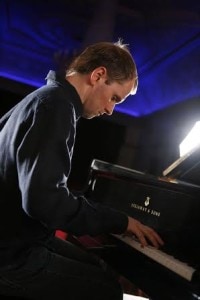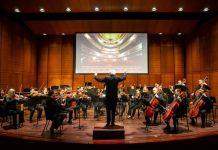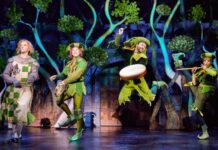Given a choice between the intellectual and the emotional, most concert-goers, in their heart of hearts, will want to hear something that moves them. They got their wish on Sunday afternoon at the Phillips Collection when Scottish pianist Steven Osborne drenched them in a boatload of Sergei Rachmaninoff’s most powerfully emotional and almost over-the-top solo piano music.

Osborne performed 10 of Rachmaninoff’s Études-Tableaux, each one of them a potentially finger-busting enterprise for keyboardists who are lesser mortals. A more-or-less literal translation of Études-Tableaux is “study pictures,” but that doesn’t quite capture the scope of these pieces. In outline they are based on the idea of an étude or “exercise” that isolates a specific keyboard technique for concentrated technical practice. But Rachmaninoff expanded the concept to make each study virtually an aural painting – certainly appropriate for performance at an art gallery – that creates a soundscape into which the listener can pour his or her own emotional reference points.
The Études-Tableaux come in two sets published as Rachmaninoff’s Opus 33 and Opus 39. The big, almost Hollywood-level moments come in the ultra-emotional Opus 39, No. 5, which has the pianist rapidly pulse chords in sets of 3 and 6 while deriving melodies either out of the top notes or from hidden themes that Rachmaninoff magically reveals out of middle of the chords. Mr. Osborne held nothing back here, and the air in the Phillips’ ornate Music Room thundered almost as if there were a symphony orchestra performing rather than a pianist, even if the accompanying pulsating chords threatened for a moment to get away from Mr. Osborne near the climax.
More completely effective were several of the other studies. Also in the Opus 39 set from 1916 and 1917, Mr. Osborne joined wistful scales and arpeggios with dabbles of single notes pulled from all around the piano in the atmospheric No. 2 in A minor. A striking moment that occurs at the end of this piece is a precursor of what later in the 20th century became a standard jazz chord (for music nerds, a rolling major seventh with an added ninth), which Rachmaninoff then closes out with a very quiet retreat to the opening A minor concept, all beautifully laid down by Mr. Osborne. He also did a great job in No. 7 of this set, which surreptitiously builds what at first sounds like plunks of almost random notes and chords into a pianistic choir of cathedral bells.
In the Opus 33 set from 1911, a highlight right at the top was No. 1, which skips staccato-like down the baritone and bass registers of the piano (which Rachmaninoff also loved to explore in his big piano concertos) against a sustained melody in the right hand.
Prior to the Rachmaninoff bounty, Mr. Osborne performed music of Franz Schubert and Claude Debussy. A particular highlight was Debussy’s L’Isle joyeuse (or “happy island,” but it sounds more meaningful in French), an ultimately virtuoso piece that goes beyond a simple nature picture to express profound human happiness at being alive.
At times Mr. Osborne did appear to have something of a challenge generating much of a warm tone out of the top ranges of the Phillips’ recently refurbished Steinway grand piano. He holds his wrist and hands a bit higher than other pianists, giving his outer fingers great independence of action but appearing to help make loud and high passages somewhat steely-sounding. To his credit, he literally asked the audience after intermission whether some of the music was simply too loud in order to attempt a slight adjustment. (Indeed there were a couple of moments during the concert where two people near me put their fingers in their ears.)
Much of this is really related to the work a number of Phillips’ world-class repeat performers are doing to adjust to the new sound of the piano, which previously had a slightly dull and inconsistent delivery right above the middle. The Phillips Music Room, always packed for these Sunday concerts in my experience, has a surprisingly intimate atmosphere for a venue that does seat about 200, and there’s a great deal of “feel” that goes into these performances.

You never know how it’s going to go when a performer starts to talk to the audience, but Mr. Osborne manifestly has the communicative touch to make this work. Particular kudos to him for an effective introduction to the Rachmaninoff Études-Tableaux. Mr. Osborne acknowledged a disconnect between a widely held academic view of Rachmaninoff’s music as insufficiently dissonant and cheaply overwrought compared to Rachmaninoff’s popularity in contemporary classical programming.
That disconnect was actually a great thing to think about for a completely rapt audience, which to my ears did not cough once the entire performance – a real rarity in these things. The massive ovation for Mr. Osborne at the end was, for once, completely genuine rather than gratuitous, and he rewarded the audience with an encore of Rachmaninoff’s gorgeous Prelude in D Major, Opus 23, No. 4. One easily imagines and hopes that Mr. Osborne will again decamp from Edinburgh and be back at the Phillips sometime in the next couple of years or so.
Pianist Steven Osborne performed on Sunday, February 28, 2016 at the Phillips Collection – 1600 21st Street NW, in Washington, DC. For upcoming events in the very active Sunday concert series in the Music Room of the Phillips Collection, see their concert schedule.




